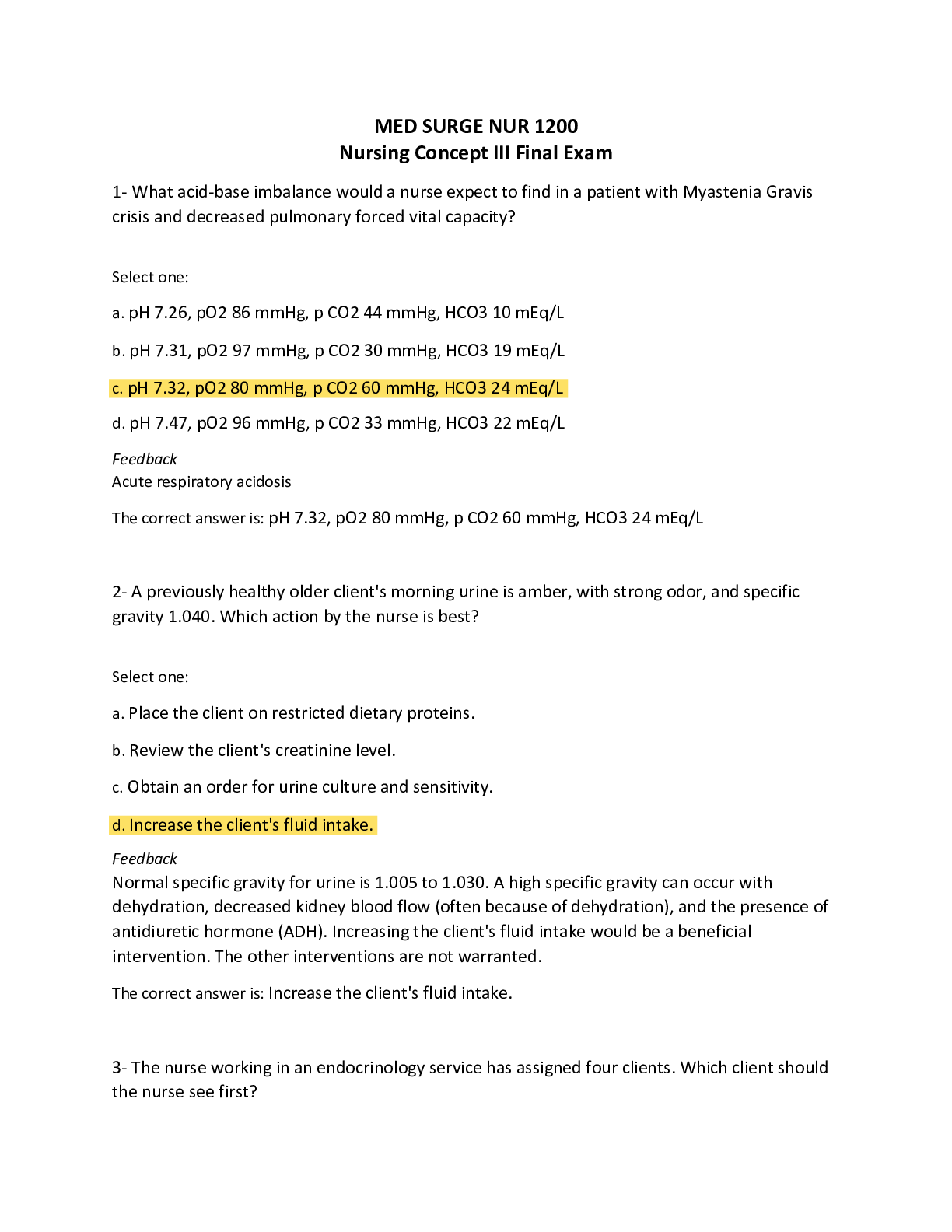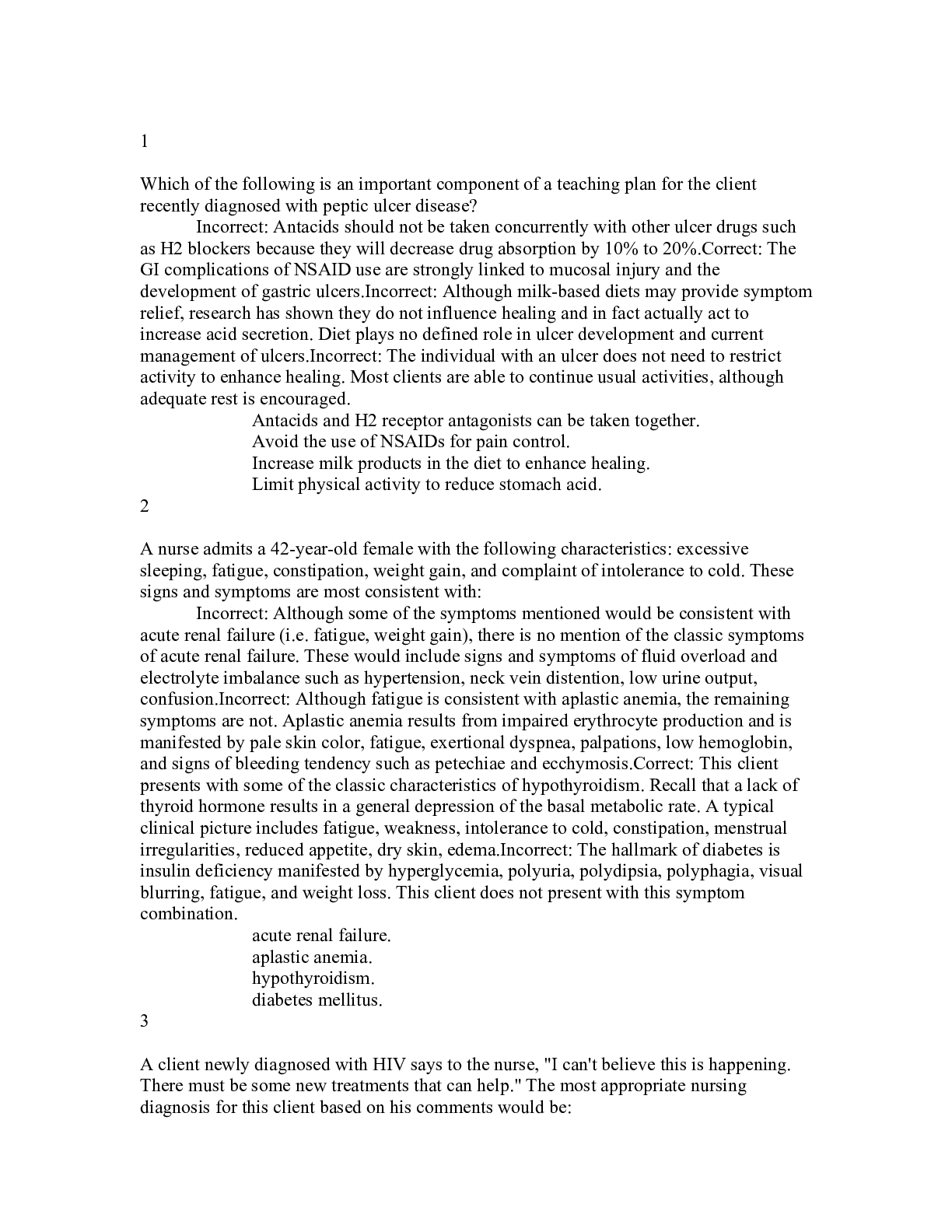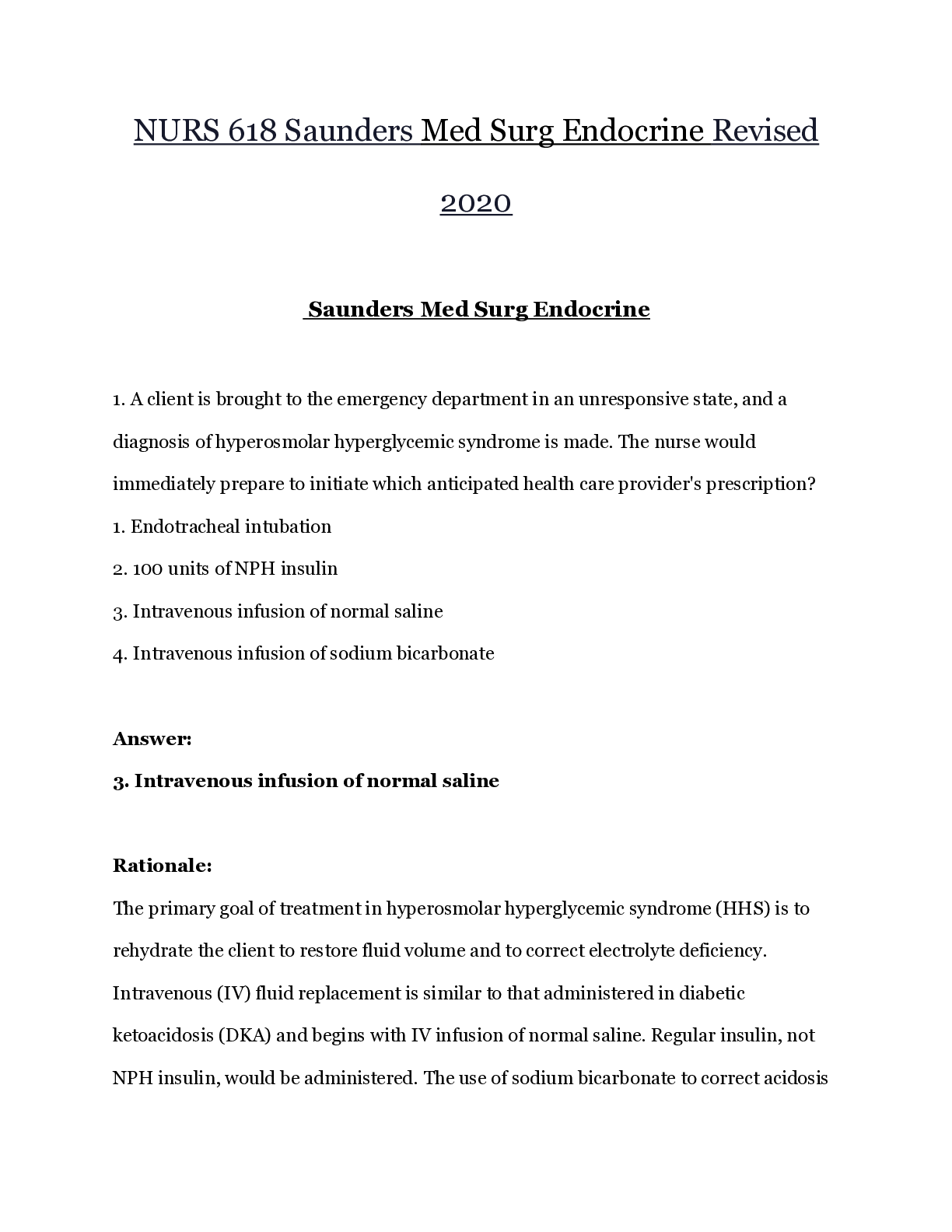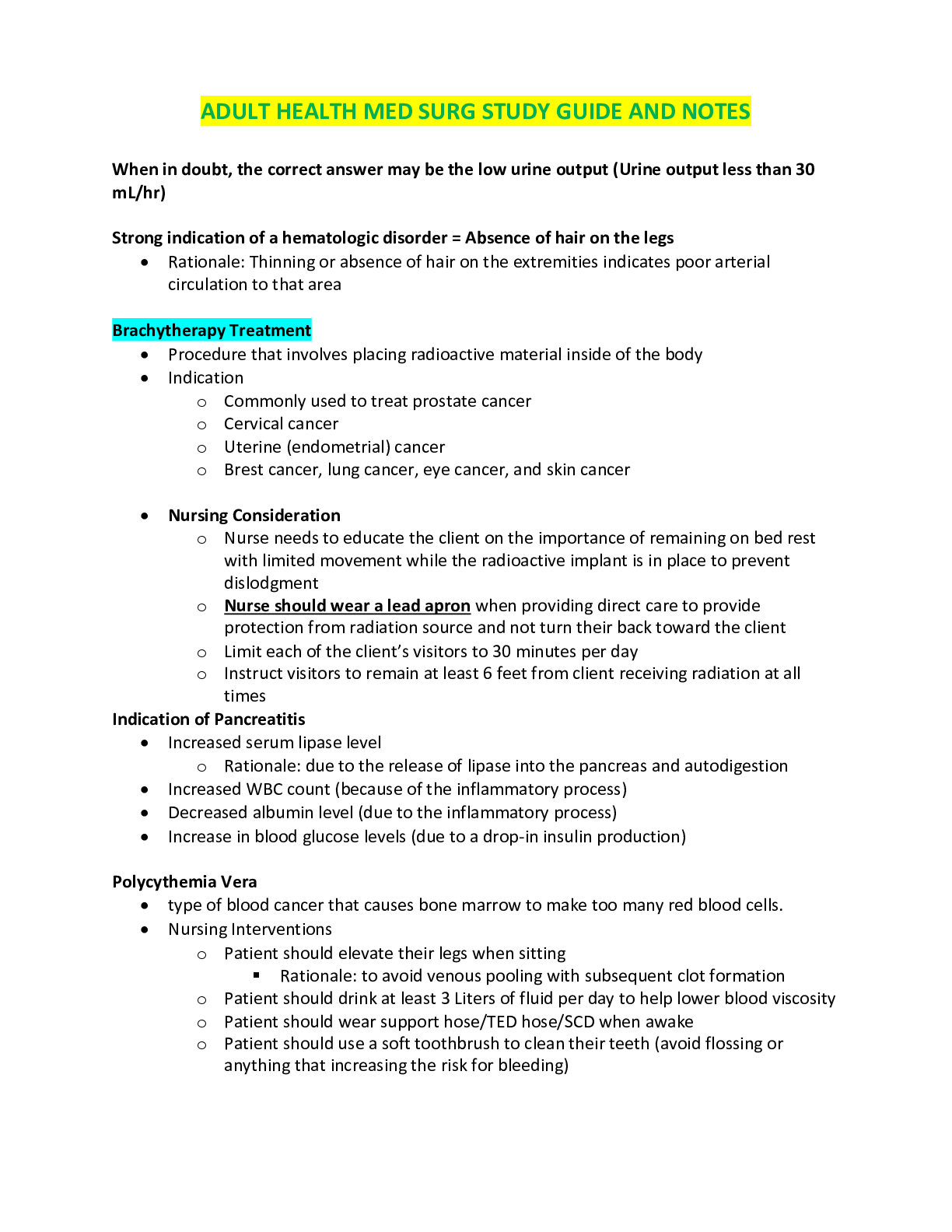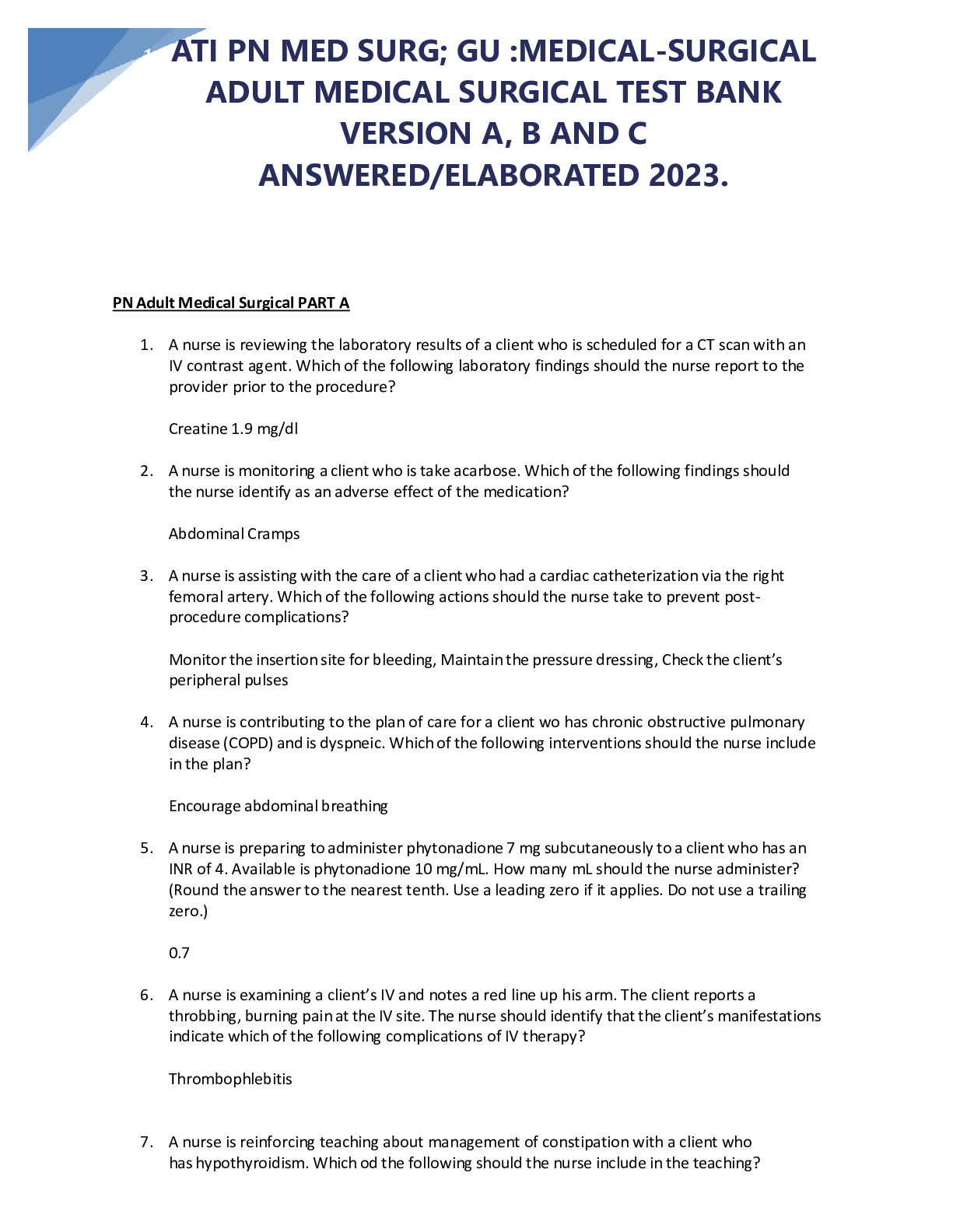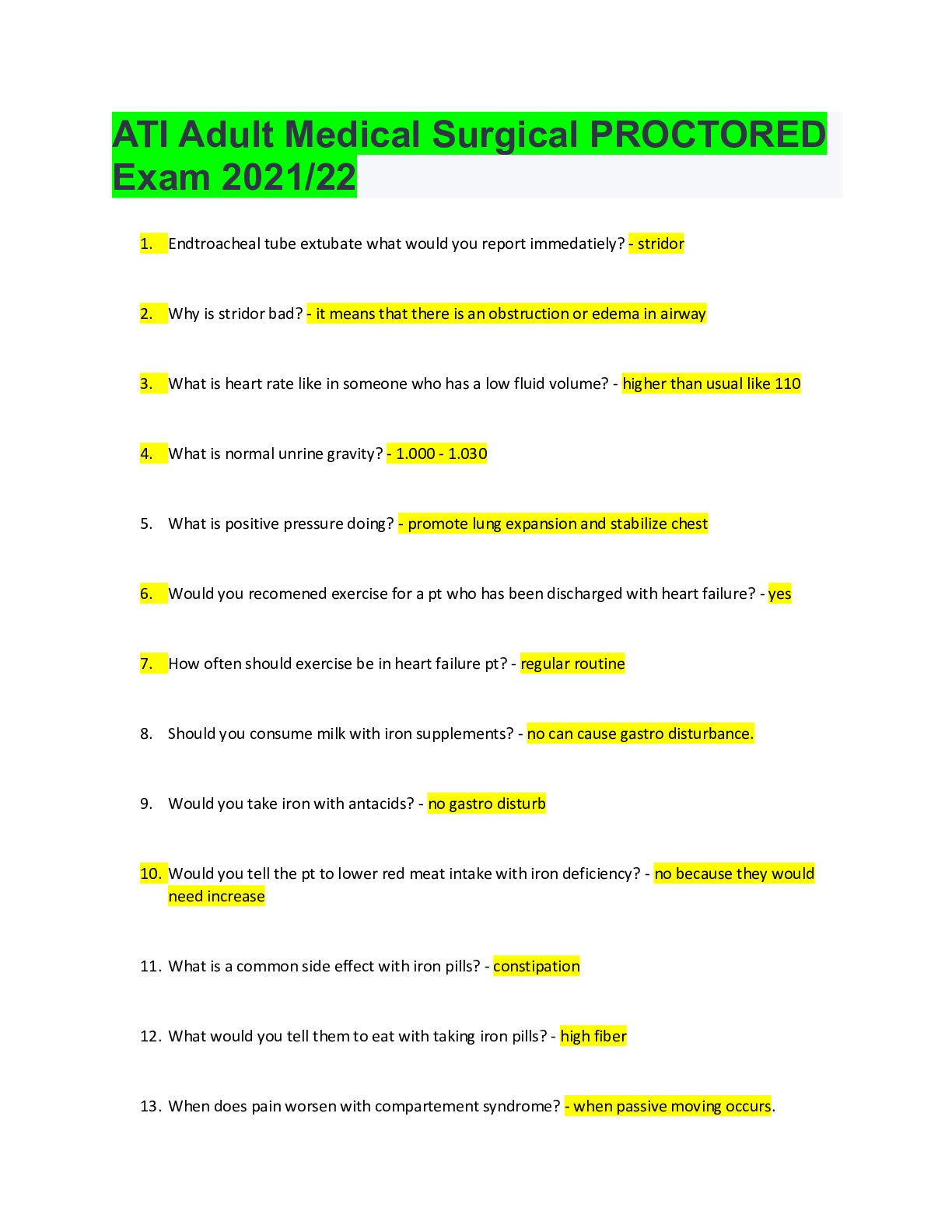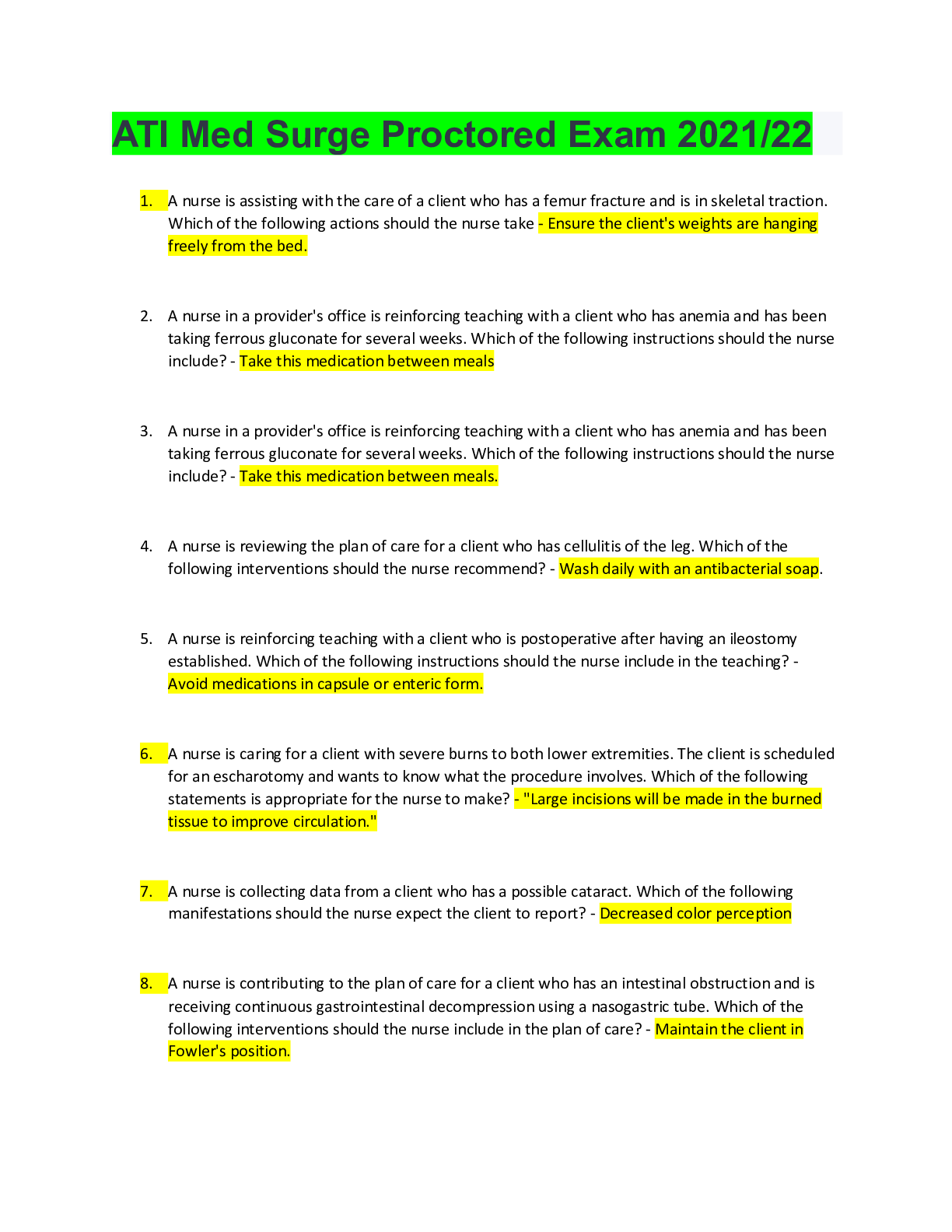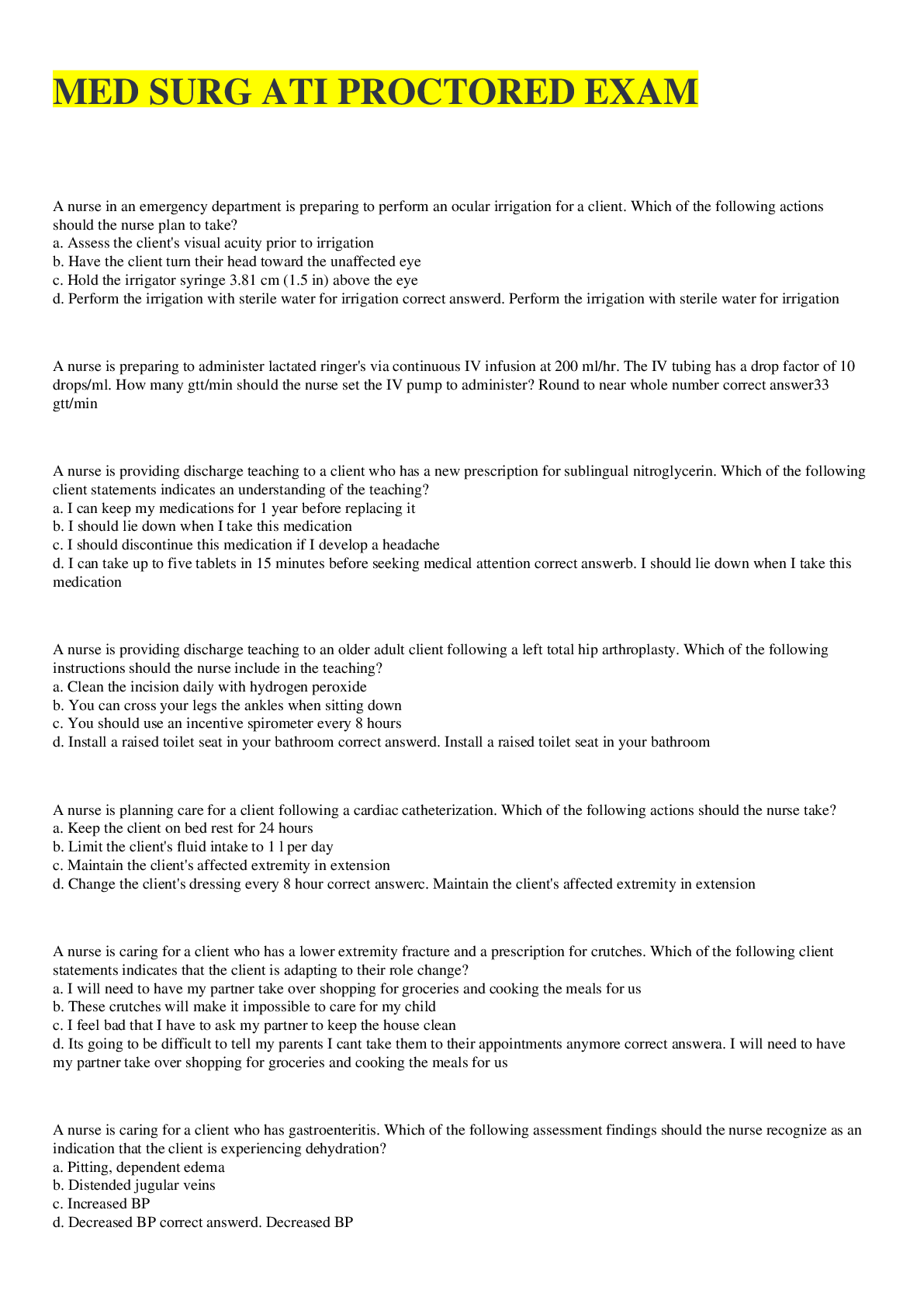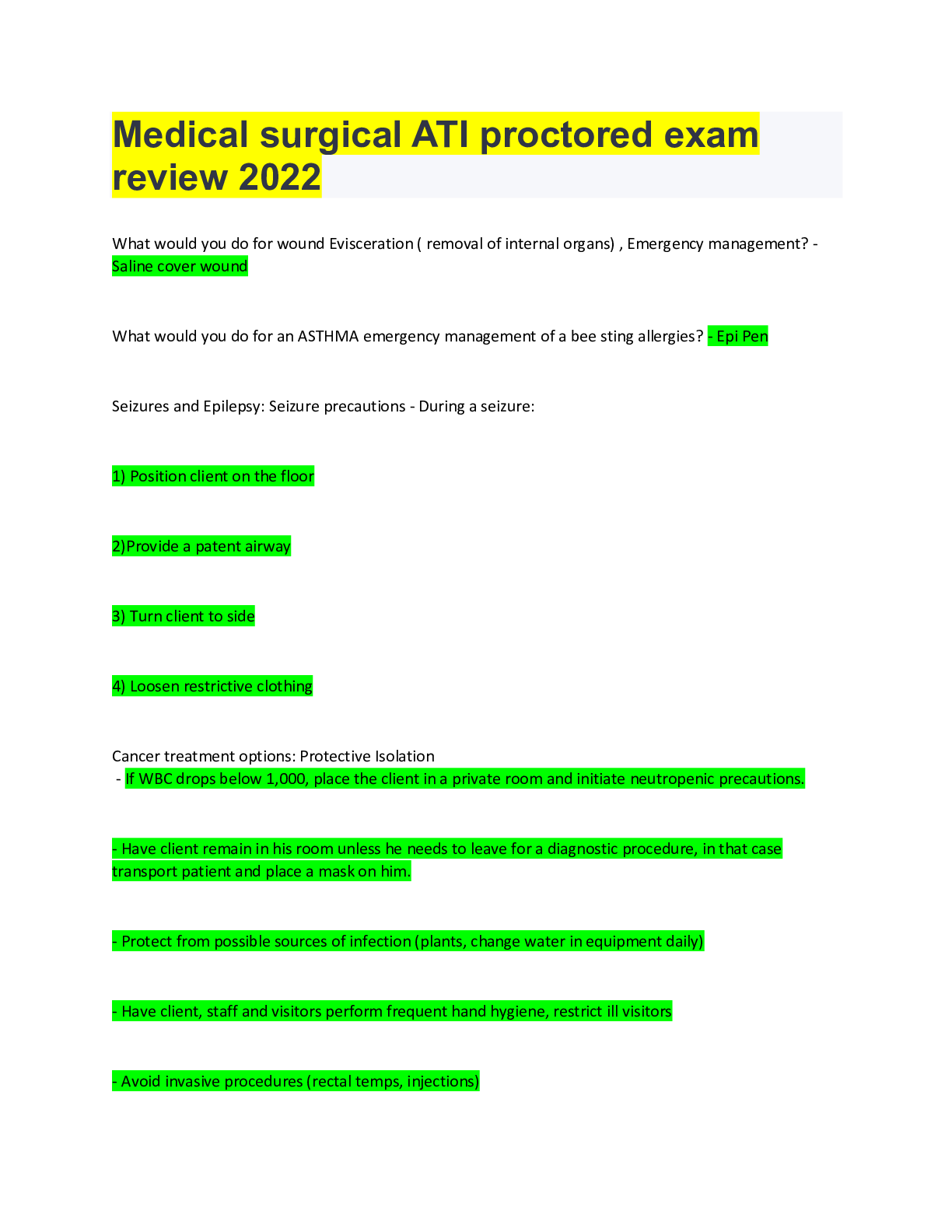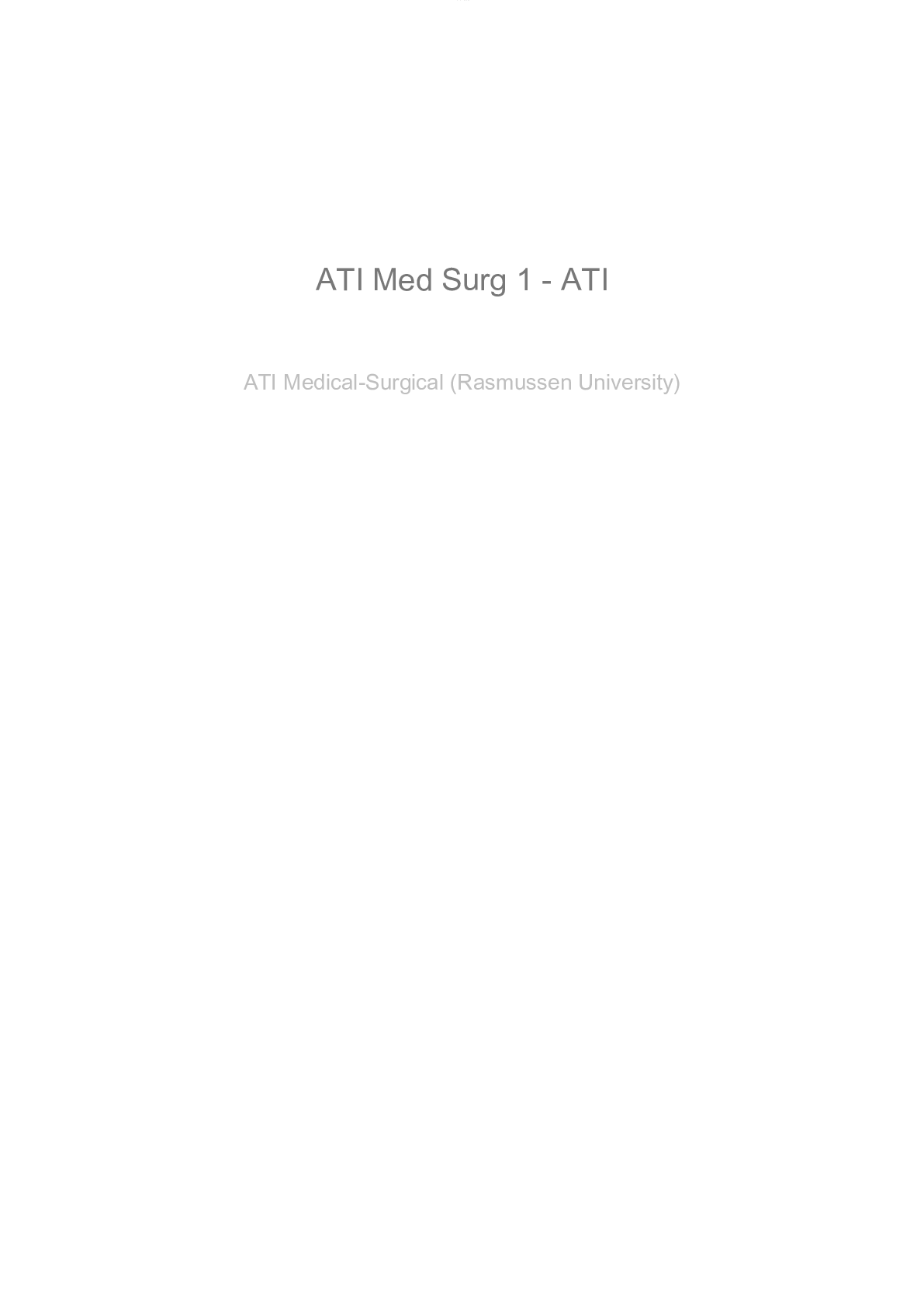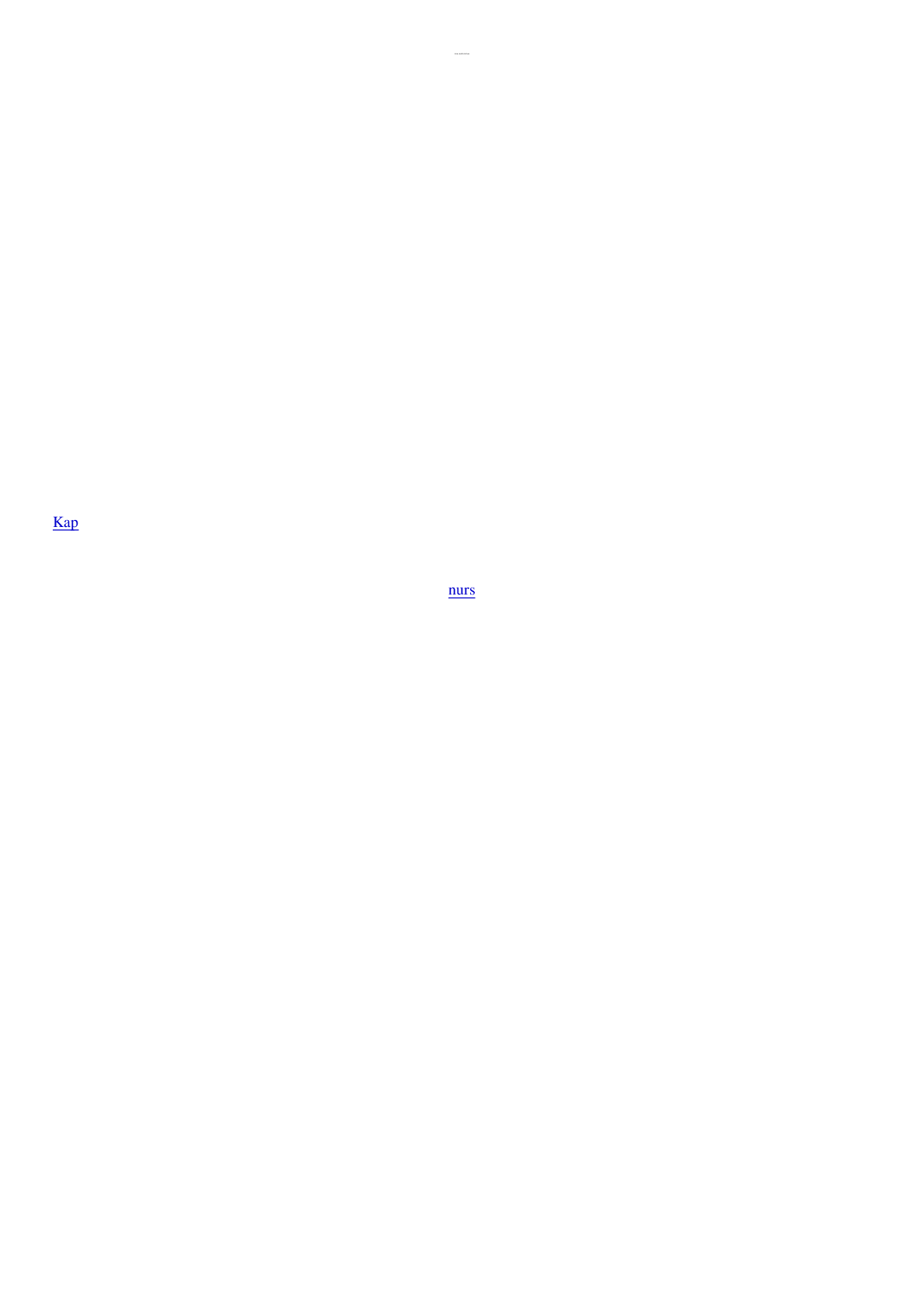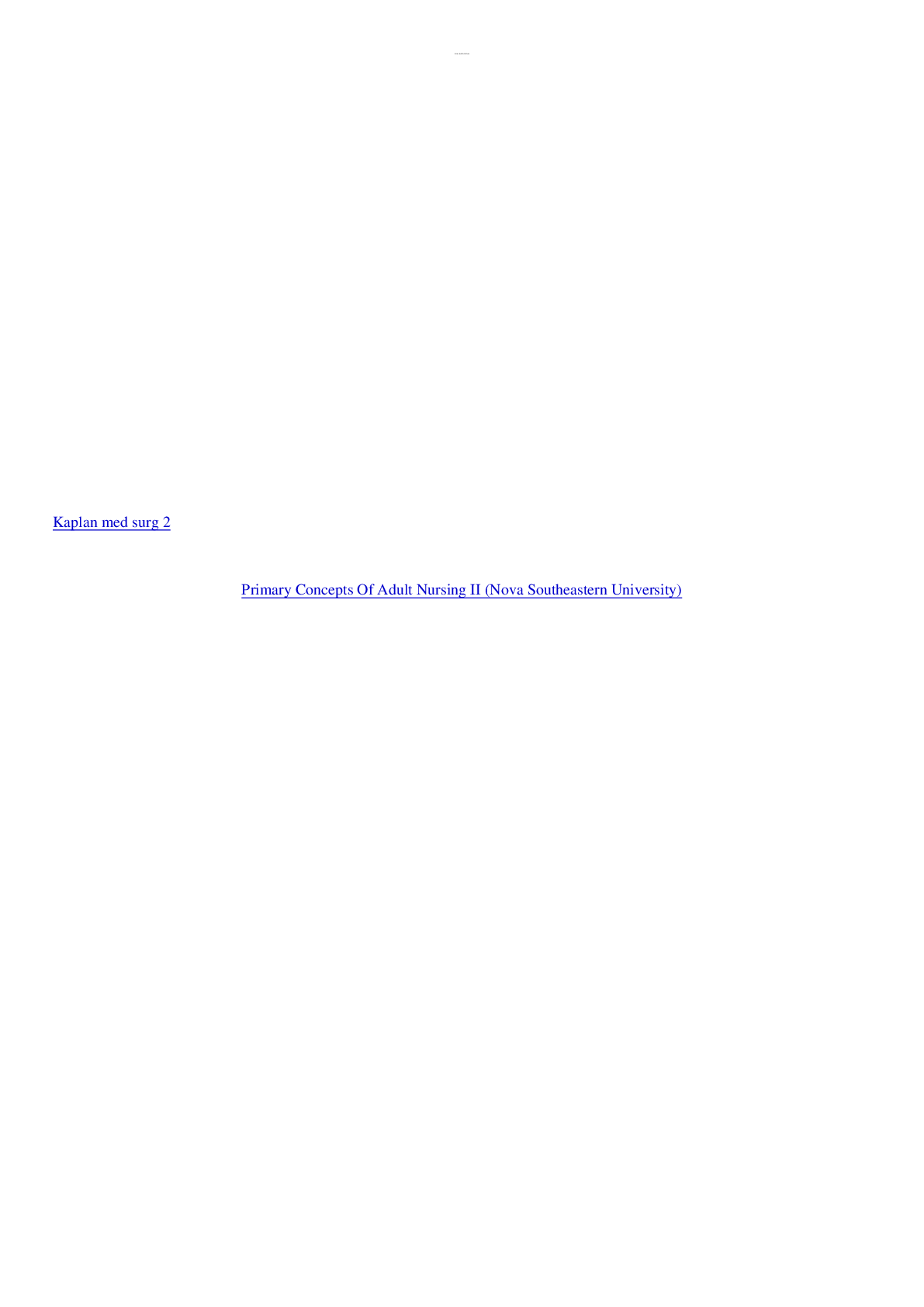*NURSING > MED-SURG EXAM > Saunders Med-surg Skin Integumentary Exam Questions Latest Review. (All)
Saunders Med-surg Skin Integumentary Exam Questions Latest Review.
Document Content and Description Below
Saunders Med-surg Skin Integumentary Exam Questions Latest Review. KEY: All un-highlighted questions are required for Medsurg 1 Red Text = Should Understand Green Text = Absolutely Should Know S... aunders Medsurg Skin Integumentary 1. A client calls the emergency department and tells the nurse that he came directly into contact with poison ivy shrubs. The client tells the nurse that he cannot see anything on the skin and asks the nurse what to do. The nurse should make which response? 1. "Come to the emergency department." 2. "Apply calamine loton immediately to the exposed skin areas." 3. "Take a shower immediately, lathering and rinsing several tmes." 4. "It is not necessary to do anything if you cannot see anything on your skin." Answer: 3. "Take a shower immediately, lathering and rinsing several tmes." Ratonale: When an individual comes in contact with a poison ivy plant, the sap from the plant forms an invisible flm on the human skin. The client should be instructed to cleanse the area by showering immediately and to lather the skin several tmes and rinse each tme in running water. Removing the poison ivy sap will decrease the likelihood of irritaton. Calamine loton may be one product recommended for use if dermatts develops. The client does not need to be seen in the emergency department at this tme. 2. A client is being admited to the hospital for treatment of acute cellulits of the lower lef leg. During the admission assessment, the nurse expects to note which fnding? 1. An inflammaton of the epidermis only 2. A skin infecton of the dermis and underlying hypodermis 3. An acute superfcial infecton of the dermis and lymphatcs 4. An epidermal and lymphatc infecton caused by Staphylococcus Answer: 2. A skin infecton of the dermis and underlying hypodermis Ratonale: Cellulits is an infecton of the dermis and underlying hypodermis that results in a deep red erythema without sharp borders and spreads widely throughout tssue spaces. The skin is erythematous, edematous, tender, and sometmes nodular. Erysipelas is an acute, superfcial, rapidly spreading inflammaton of the dermis and lymphatcs. The infecton is not superfcial and extends deeper than the epidermis.3. The clinic nurse assesses the skin of a client with psoriasis afer the client has used a new topical treatment for 2 months. The nurse identfes which characteristcs as improvement in the manifestatons of psoriasis? Select all that apply. 1. Presence of striae 2. Palpable radial pulses 3. Absence of any ecchymosis on the extremites 4. Thinner and decrease in number of reddish papules 5. Scarce amount of silvery-white scaly patches on the arms Answers: 4. Thinner and decrease in number of reddish papules 5. Scarce amount of silvery-white scaly patches on the arms Ratonale: Psoriasis skin lesions include thick reddened papules or plaques covered by silvery-white patches. A decrease in the severity of these skin lesions is noted as an improvement. The presence of striae (stretch marks), palpable pulses, or lack of ecchymosis is not related to psoriasis. 4. The clinic nurse notes that the health care provider has documented a diagnosis of herpes zoster (shingles) in the client's chart. Based on an understanding of the cause of this disorder, the nurse determines that this defnitve diagnosis was made by which diagnostc test? 1. Positve patch test 2. Positve culture results 3. Abnormal biopsy results 4. Wood's light examinaton indicatve of infecton Answer: 2. Positve culture results Ratonale: With the classic presentaton of herpes zoster, the clinical examinaton is diagnostc. However, a viral culture of the lesion provides the defnitve diagnosis. Herpes zoster (shingles) is caused by a reactvaton of the varicella-zoster virus, the virus that causes chickenpox. A patch test is a skin test that involves the administraton of an allergen to the surface of the skin to identfy specifc allergies. A biopsy would provide a cytological examinaton of tssue. In a Wood's light examinaton, the skin is viewed under ultraviolet light to identfy superfcial infectons of the skin. 5. A client returns to the clinic for follow-up treatment following a skin biopsy of a suspicious lesion performed 1 week ago. The biopsy report indicates that the lesion is a melanoma. The nurse understands that melanoma has which characteristcs? Select all that apply. 1. Lesion is painful to touch. 2. Lesion is highly metastatc. 3. Lesion is a nevus that has changes in color. 4. Skin under the lesion is reddened and warm to touch.5. Lesion occurs in body area exposed to outdoor sunlight. Answers: 2. Lesion is highly metastatc. 3. Lesion is a nevus that has changes in color. Ratonale: Melanomas are pigmented malignant lesions originatng in the melanin-producing cells of the epidermis. Melanomas cause changes in a nevus (mole), including color and borders. This skin cancer is highly metastatc, and a person's survival depends on early diagnosis and treatment. Melanomas are not painful or accompanied by sign of inflammaton. Although sun exposure increases the risk of melanoma, lesions are most commonly found on the upper back and legs and on the soles and palms of persons with dark skin. 7. A client arriving at the emergency department has experienced frostbite to the right hand. Which fnding would the nurse note on assessment of the client's hand? 1. A pink, edematous hand 2. Fiery red skin with edema in the nail beds 3. Black fngertps surrounded by an erythematous rash 4. A white color to the skin, which is insensitve to touch Answer: 4. A white color to the skin, which is insensitve to touch Ratonale: Assessment fndings in frostbite include a white or blue color; the skin will be hard, cold, and insensitve to touch. As thawing occurs, flushing of the skin, the development of blisters or blebs, or tssue edema appears. Optons 1, 2, and 3 are incorrect. 8. The evening nurse reviews the nursing documentaton in a client's chart and notes that the day nurse has documented that the client has a stage II pressure ulcer in the sacral area. Which fnding would the nurse expect to note on assessment of the client's sacral area? 1. Intact skin 2. Full-thickness skin loss 3. Exposed bone, tendon, or muscle 4. Partal-thickness skin loss of the dermis Answer: 4. Partal-thickness skin loss of the dermis Ratonale: In a stage II pressure ulcer, the skin is not intact. Partal-thickness skin loss of the dermis has occurred. It presents as a shallow open ulcer with a red-pink wound bed, without slough. It may also present as anintact or open/ruptured serum-flled blister. The skin is intact in stage I. Full-thickness skin loss occurs in stage III. Exposed bone, tendon, or muscle is present in stage IV. 9. An adult client was burned in an explosion. The burn initally affected the client's entre face (anterior half of the head) and the upper half of the anterior torso, and there were circumferental burns to the lower half of both arms. The client's clothes caught on fre, and the client ran, causing subsequent burn injuries to the posterior surface of the head and the upper half of the posterior torso. Using the rule of nines, what would be the extent of the burn injury? 1. 18% 2. 24% 3. 36% 4. 48% Answer: 3. 36% Ratonale: According to the rule of nines, with the inital burn, the anterior half of the head equals 4.5%, the upper half of the anterior torso equals 9%, and the lower half of both arms equals 9%. The subsequent burn included the posterior half of the head, equaling 4.5%, and the upper half of posterior torso, equaling 9%. This totals 36%. 10. The nurse is preparing to care for a burn client scheduled for an escharotomy procedure being performed for a third-degree circumferental arm burn. The nurse understands that which fnding is the antcipated therapeutc outcome of the escharotomy? 1. Return of distal pulses 2. Brisk bleeding from the site 3. Decreasing edema formaton 4. Formaton of granulaton tssue Answer: 1. Return of distal pulses Ratonale: Escharotomies are performed to relieve the compartment syndrome that can occur when edema forms under nondistensible eschar in a circumferental third-degree burn. The escharotomy releases the tourniquet-like compression around the arm. Escharotomies are performed through avascular eschar to subcutaneous fat. Although bleeding may occur from the site, it is considered a complicaton rather than an antcipated therapeutc outcome. Usually, direct pressure with a bulky dressing and elevaton control the bleeding, but occasionally an artery is damaged and may require ligaton. Escharotomy does not affect the formaton of edema. Formaton of granulaton tssue is not the intent of an escharotomy.11. The nurse is caring for a client who sustained superfcial partal-thickness burns on the anterior lower legs and anterior thorax. Which fnding does the nurse expect to note during the resuscitaton/emergent phase of the burn injury? 1. Decreased heart rate 2. Increased urinary output 3. Increased blood pressure 4. Elevated hematocrit levels Answer: 4. Elevated hematocrit levels Ratonale: The resuscitaton/emergent phase begins at the tme of injury and ends with the restoraton of capillary permeability, usually at 48 to 72 hours following the injury. During the resuscitaton/emergent phase, the hematocrit level increases to above normal because of hemoconcentraton from the large fluid shifs. Hematocrit levels of 50% to 55% (0.50 to 0.55) are expected during the frst 24 hours afer injury, with return to normal by 36 hours afer injury. Initally, blood is shunted away from the kidneys and renal perfusion and glomerular fltraton are decreased, resultng in low urine output. The burn client is prone to hypovolemia and the body atempts to compensate by increased pulse rate and lowered blood pressure. Pulse rates are typically higher than normal, and the blood pressure is decreased as a result of the large fluid shifs. 12. The nurse is administering fluids intravenously as prescribed to a client who sustained superfcial partal-thickness burn injuries of the back and legs. In evaluatng the adequacy of fluid resuscitaton, the nurse understands that which assessment would provide the most reliable indicator for determining the adequacy? 1. Vital signs 2. Urine output 3. Mental status 4. Peripheral pulses Answer: 2. Urine output Ratonale: Successful or adequate fluid resuscitaton in the client is signaled by stable vital signs, adequate urine output, palpable peripheral pulses, and clear sensorium. However, the most reliable indicator for determining adequacy of fluid resuscitaton, especially in a client with burns, is the urine output. For an adult, the hourly urine volume should be 30 to 50 mL. 13. The nurse is caring for a client following an autograf and grafing to a burn wound on the right knee. What would the nurse antcipate to be prescribed for the client? 1. Out-of-bed actvites 2. Bathroom privileges 3. Immobilizaton of the affected leg4. Placing the affected leg in a dependent positon Answer: 3. Immobilizaton of the affected leg Ratonale: Autografs placed over joints or on the lower extremites afer surgery ofen are elevated and immobilized for 3 to 7 days. This period of immobilizaton allows the autograf tme to adhere to the wound bed. Getng out of bed, going to the bathroom, and placing the grafed leg dependent would put stress on the grafed wound. 14. The health educaton nurse provides instructons to a group of clients regarding measures that will assist in preventng skin cancer. Which instructons should the nurse provide? Select all that apply. 1. Sunscreen should be applied every 8 hours. 2. Use sunscreen when partcipatng in outdoor actvites. 3. Wear a hat, opaque clothing, and sunglasses when in the sun. 4. Avoid sun exposure in the late afernoon and early evening hours. 5. Examine your body monthly for any lesions that may be suspicious. Answers: 2. Use sunscreen when partcipatng in outdoor actvites. 3. Wear a hat, opaque clothing, and sunglasses when in the sun. 5. Examine your body monthly for any lesions that may be suspicious. Ratonale: The client should be instructed to avoid sun exposure between the hours of brightest sunlight: 10 a.m. and 4 p.m. Sunscreen, a hat, opaque clothing, and sunglasses should be worn for outdoor actvites. The client should be instructed to examine the body monthly for the appearance of any cancerous or any precancerous lesions. Sunscreen should be reapplied every 2 to 3 hours and afer swimming or sweatng; otherwise, the duraton of protecton is reduced. 27. The community health nurse is visitng a homeless shelter and is assessing the clients in the shelter for the presence of scabies. Which assessment fnding should the nurse expect to note if scabies is present? 1. Brown-red macules with scales 2. Pustules on the trunk of the body 3. White patches noted on the elbows and knees 4. Multple straight or wavy threadlike lines underneath the skin Answer: 4. Multple straight or wavy threadlike lines underneath the skin Ratonale:Scabies can be identfed by the multple straight or wavy threadlike lines beneath the skin. The skin lesions are caused by the female, which burrows beneath the skin to lay its eggs. The eggs hatch in a few days, and the baby mites fnd their way to the skin surface, where they mate and complete the life cycle. Optons 1, 2, and 3 are not characteristcs of scabies. 29. The nurse is concerned about potental skin integrity problems for an unconscious client. Which interventons would be most appropriate to include in the plan of care for this client? Select all that apply. 1. Repositon every 2 hours. 2. Use a bed cradle as indicated. 3. Apply protectve pads to heels and elbows. 4. Add a small amount of alcohol to the daily bath water. 5. Provide perineal care every 8 hours and afer incontnence. Answers: 1. Repositon every 2 hours. 2. Use a bed cradle as indicated. 3. Apply protectve pads to heels and elbows. 5. Provide perineal care every 8 hours and afer incontnence. Ratonale: Unconscious clients are completely immobile, having lost the protectve reflexes to shif body weight. It is up to the nurse to minimize the risk of prolonged pressure that could cause skin ischemia and breakdown. This is accomplished by repositoning the client every 2 hours. Use of a bed cradle can protect the client's toes from breakdown due to weight from linens. Protectve pads can be applied to the heels and elbows to reduce fricton and shear. Appropriate perineal care is essental to keep waste products from excoriatng the skin. The nurse can reduce skin dryness and irritaton by adding a superfaty soluton (such as baby oil or castle soap) to the daily bath water. Drying agents such as alcohol are avoided because dry skin can crack and break down. 30. The emergency department nurse is caring for a client who has sustained chemical burns to the esophagus afer ingeston of lye. The nurse reviews the health care provider's prescriptons and should plan to queston which prescripton? 1. Gastric lavage 2. Intravenous (IV) fluid therapy 3. Nothing by mouth (NPO) status 4. Preparaton for laboratory studies Answer: 1. Gastric lavage Ratonale:The client who has sustained chemical burns to the esophagus is placed on NPO status, is given IV fluids for replacement and treatment of possible shock, and is prepared for esophagoscopy and barium swallow to determine the extent of damage. Laboratory studies also may be prescribed. A nasogastric tube may be inserted, but gastric lavage and emesis are avoided to prevent further erosion of the mucosa by the irritatng substances that these treatments involve. 31. The nurse is conductng a screening program to identfy clients at risk for an integumentary disorder. Which client seen at the screening would most likely be at risk for development of an integumentary disorder? 1. An athlete 2. An adolescent 3. An older client 4. A client who tans in an indoor tanning bed Answer: 4. A client who tans in an indoor tanning bed Ratonale: Prolonged exposure to the sun (including indoor tanning), unusual cold, or other extreme conditons can damage the skin, posing the highest risk for skin disorders. An athlete would be at low risk of developing an integumentary problem. An adolescent may be prone to the development of acne, but this does not occur in all adolescents. An older client may be at a higher risk than a younger person. 32. The nurse is providing informaton to a client scheduled for a skin biopsy. The client asks the nurse how painful the procedure is. The nurse should make which response to the client? 1. "The procedure is painless." 2. "A preoperatve medicaton will put you to sleep." 3. "An analgesic will be prescribed afer the procedure." 4. "The local anesthetc may cause a stnging sensaton." Answer: 4. "The local anesthetc may cause a stnging sensaton." Ratonale: A skin biopsy is not painless. The most common source of pain during a skin biopsy is the inital local anesthetc, which can produce a burning or stnging sensaton. A preoperatve medicaton that puts the client to sleep is not a component of this procedure. Analgesics may be prescribed afer the procedure, but this opton does not address the issue related to the amount or type of pain associated with the procedure itself. 33. The nurse is reviewing the discharge instructons for the client who had a skin biopsy. Which statement, if made by the client, would indicate a need for further instructon? 1. "I will keep the dressing dry." 2. "I will watch for any drainage from the wound."3. "I will use the antbiotc ointment as prescribed." 4. "I will return tomorrow to have the sutures removed." Answer: 4. "I will return tomorrow to have the sutures removed." Ratonale: Sutures usually are removed 7 to 10 days afer a skin biopsy, depending on health care provider (HCP) preference. Afer a skin biopsy, the nurse instructs the client to keep the dressing dry and in place for a minimum of 8 hours as prescribed. Afer the dressing is removed, the site is cleaned once a day with tap water or saline to remove any dry blood or crusts. The HCP may prescribe an antbiotc ointment to minimize local bacterial colonizaton. The nurse instructs the client to report any redness or excessive drainage at the site. The site may be closed with sutures or may be allowed to heal without suturing. 34. The nurse prepares to assist the health care provider to examine the client's skin with a Wood's lamp. Which should be included in the preprocedure plan of care? 1. Shave the skin site. 2. Prepare a local anesthetc. 3. Obtain an informed consent. 4. Tell the client that the procedure is painless. Answer: 4. Tell the client that the procedure is painless. Ratonale: A Wood's light examinaton is a painless procedure. The skin does not need to be shaved, and a local anesthetc is not necessary. Examinaton of the skin under a Wood's lamp is always carried out in a darkened room. This is a noninvasive examinaton; therefore, an informed consent is not required. A hand-held long-wavelength ultraviolet light source or Wood's lamp is used. Areas of blue-green or red fluorescence are associated with certain skin infectons. 36. The home care nurse visits an older client who was discharged from the hospital afer diagnostc testng. The client complains of chronic dry skin and episodes of pruritus. Which measure should the nurse recommend for the client to alleviate this discomfort? 1. Run a dehumidifer in the home. 2. Apply astringents to the skin twice daily. 3. Apply emollients to the skin afer bathing. 4. Take baths twice daily using a dilute soluton of alcohol and water. Answer: 3. Apply emollients to the skin afer bathing. Ratonale:One bath or one shower per day for 15 to 20 minutes with warm water and a mild soap should be followed immediately by the applicaton of an emollient to prevent evaporaton of water from the hydrated epidermis. The client should avoid using a dehumidifer because this will further dry room air. The client should be instructed to avoid applying rubbing alcohol, astringents, or other drying agents to the skin. A bath using a dilute alcohol soluton will cause further drying of the skin. 37. The nurse is providing an educatonal session to community members regarding Lyme disease. The nurse should provide what informaton regarding this disease? 1. It is caused by a tck bite. 2. It can be contagious by skin contact with an infected person. 3. It can be caused by the inhalaton of spores from bird droppings. 4. It is caused by contaminaton from cat feces or the consumpton of rare or raw meat. Answer: 1. It is caused by a tck bite. Ratonale: Lyme disease is a multsystem infecton that results from a bite by a tck that is usually carried by several species of deer. Persons biten by the Ixodes tcks are infected with the spirochete Borrelia burgdorferi. Lyme disease cannot be transmited from 1 person to another. Histoplasmosis is caused by the inhalaton of spores from bat or bird droppings. Toxoplasmosis is caused from the inhalaton of cysts from contaminated cat feces or the consumpton of rare or raw meat. 38. A client is being admited to the hospital for treatment of acute cellulits of the lower lef leg, and a nursing student is assigned to provide care for the client. The nursing instructor asks the student to describe this diagnosis. Which answer demonstrates the student's understanding of the diagnosis? 1. "It is an acute superfcial infecton." 2. "It is an inflammaton of the epidermis." 3. "Staphylococcus is the cause of this epidermal infecton." 4. "This skin infecton involves the deep dermis and subcutaneous fat." Answer: 4. "This skin infecton involves the deep dermis and subcutaneous fat." Ratonale: Cellulits is a skin infecton into deeper dermis and subcutaneous fat that results in deep red erythema without sharp borders and spreads widely through tssue spaces. The skin is erythematous, edematous, tender, and sometmes nodular. Optons 1, 2, and 3 are incorrect descriptons. 39. The nurse expects to note which prescripton for a client with a skin infecton that extends into the dermis? 1. Applying warm compresses to the affected area 2. Placing iced compresses to the affected area every 4 hours 3. Alternatng the applicaton of hot and iced compresses every 2 hours4. Placing antbiotc ointment on the affected site followed by contnuous heat lamp applicaton Answer: 1. Applying warm compresses to the affected area Ratonale: Warm compresses may be prescribed to decrease the discomfort, erythema, and edema associated with a skin infecton that is characteristc of cellulits. The nurse should also provide supportve care as prescribed to manage associated symptoms such as fever or chills. Afer tssue and blood are obtained for culture, antbiotcs are initated. Heat lamps can cause more disrupton to already inflamed tssue. Iced compresses are not prescribed because they can damage tssue. 40. The nurse is performing an assessment on a client suspected of having herpes zoster. The nurse would expect to note which types of lesions on inspecton of the client's skin? 1. Clustered skin vesicles 2. A generalized body rash 3. Small blue-white spots with a red base 4. A fery-red edematous rash on the cheeks Answer: 1. Clustered skin vesicles Ratonale: The primary lesion of herpes zoster is a vesicle. The classic presentaton is grouped vesicles on an erythematous base along a dermatome. Because they follow nerve pathways, the lesions do not cross the body's midline. Optons 2, 3, and 4 are incorrect descriptons. 42. The nurse is providing instructons regarding skin care to a client afer removal of a leg cast. The nurse should instruct the client to take which measure? 1. Avoid the use of sunscreen on the skin for at least 2 years. 2. Apply an emollient loton to the skin to enhance sofening. 3. Scrub the skin vigorously with soap and water to remove the dead skin. 4. Soak the skin for 1 hour 6 tmes daily to assist in removing any dry scales. Answer: 2. Apply an emollient loton to the skin to enhance sofening. Ratonale: The skin under a casted area may be discolored and crusted with dead skin layers. The client should gently soak and wash the skin for the frst few days; however, soaking for 1 hour 6 tmes daily is excessive and could lead to skin breakdown. The skin should not be scrubbed vigorously because this acton also could lead to skin breakdown. The skin should be pated dry, and a lubricatng loton should be applied. The client should avoid overexposing the skin to the sunlight.43. A client sustains a burn injury to the entre right and lef arms, the right leg, and the anterior thorax. According to the rule of nines, the nurse would assess that this injury consttutes which body percentage? Fill in the blank. Answer: 54% Ratonale: According to the rule of nines, the right arm is equal to 9% and the lef arm is equal to 9%. The right leg is equal to 18% and the lef leg is equal to 18%. The anterior thorax is equal to 18% and the posterior thorax is equal to 18%. The head is equal to 9% and the perineum is equal to 1%. If the anterior thorax, the right leg, and the right and lef arms were burned, according to the rule of nines, the total area involved would be 54%. 44. The nurse has applied a hypothermia blanket to a client with a fever. A priority for the nurse is to inspect the skin frequently to detect which complicaton of hypothermia blanket use? 1. Frostbite 2. Skin breakdown 3. Venous insufciency 4. Arterial insufciency Answer: 2. Skin breakdown Ratonale: When a hypothermia blanket is used, the skin is inspected frequently for pressure points, which over tme could lead to skin breakdown. Optons 1, 3, and 4 are not complicatons. 45. A client with severe psoriasis has a problem of chronic low self-esteem. The nurse should incorporate which nursing acton when working with this client? 1. Listening atentvely 2. Keeping communicatons brief 3. Approaching the client in a formal manner 4. Avoiding looking at the affected skin areas Answer: 1. Listening atentvely Ratonale: Clients with chronic skin disorders may experience chronic low self-esteem because of the disorder itself and possible rejecton by others. The nurse demonstrates acceptance of the client by using a quiet, unhurried manner and by using appropriate visual contact, facial expression, and therapeutc touch. Communicatons that seem brief and formal may reinforce the feelings of rejecton, as may avoidance of looking at the affected skin areas.46. A client is admited to the hospital emergency department afer receiving a burn injury in a house fre. The skin on the client's trunk is tan, dry, and hard. It is edematous but not very painful. The nurse determines that this client's burn should be classifed as which type? 1. Superfcial 2. Full-thickness 3. Deep partal-thickness 4. Partal-thickness superfcial Answer: 2. Full-thickness Ratonale: Full-thickness burns involve the epidermis, the full dermis, and some of the subcutaneous fat layer. The burn appears to be a tan or fawn color, with skin that is hard, dry, and inelastc. Edema is severe, and the accumulated fluid compresses tssue underneath because of eschar formaton. Some nerve endings have been damaged, and the area may be insensitve to touch, with litle or no pain. 47. A client who is being evaluated for thermal burn injuries to the arms and legs complains of thirst and asks the nurse for a drink. Which acton by the nurse is most appropriate? 1. Allow the client to have full liquids. 2. Give the client small glasses of clear liquids. 3. Order the client a full meal tray with extra liquids. 4. Keep the client on NPO (nothing by mouth) status. Answer: 4. Keep the client on NPO (nothing by mouth) status. Ratonale: The client should be maintained on NPO status because burn injuries frequently result in paralytc ileus. The client also should be told that fluids could cause vomitng because of the effect of the burn injury on gastrointestnal tract functoning. Mouth care should be given as appropriate to alleviate the sensaton of thirst. 48. A client has sustained a superfcial skin tear to the arm. The nurse should apply which dressing as the best type of bandage for this wound? 1. Dry sterile dressing 2. Wet to dry dressing 3. Gelfoam sponge dressing 4. Semipermeable flm dressing Answer: 4. Semipermeable flm dressingRatonale: Semipermeable flm dressings are used on superfcial wounds, on ulcers, and occasionally on some deep, draining, or necrotc ulcers. These dressings have the advantage of staying in place for several days, allowing tssues to heal underneath. Dry sterile dressings would stck to the wound and are inappropriate. Wet to dry dressings are unnecessary because the tssue does not need debridement. Gelfoam sponge dressings are a type of enzyme dressing used in the treatment of necrotc tssue. 49. A client is on nothing by mouth (NPO) status and has a nasogastric (NG) tube in place afer suffering bilateral burns to the legs. The nurse determines that the client's gastrointestnal (GI) status is least satsfactory if which fnding is noted on assessment? 1. Gastric pH of 3 2. Absence of abdominal discomfort 3. GI drainage that is guaiac negatve 4. Presence of hypoactve bowel sounds Answer: 1. Gastric pH of 3 Ratonale: The gastric pH should be maintained at 7 or greater with the use of prescribed antacids and histamine 2 (H2) receptor–blocking agents. Lowered pH (to the acidic range) in the absence of food or tube feedings can lead to erosion of the gastric lining and ulcer development. Absence of discomfort and bleeding (guaiac-negatve drainage) are normal fndings. The client's bowel sounds may be expected to be hypoactve in the absence of oral or NG tube intake. 50. The nurse has a prescripton to get a client who is paraplegic out of bed and into a chair. The nurse determines which item would be best to put in the chair under the client? 1. Pillow 2. Foam pad 3. Folded blankets 4. Plastc-lined absorbent pad Answer: 2. Foam pad Ratonale: The client who cannot shif weight unassisted should have a pressure relief pad in place under the butocks to prevent skin breakdown. The best products for this purpose are those that have a tendency to equalize the client's weight on the pad. These include foam, water, gel, and alternatng air products. A pillow provides cushion but does not distribute weight equally. A plastc-lined pad and folded blankets provide no pressure relief. 51. A client is experiencing chronic pruritus. To promote hydraton of the skin, the nurse should tell the client to take which measure?1. Maintain room humidity at less than 40%. 2. Use very hot or very cold water for bathing. 3. Apply emollients once the skin is thoroughly dry. 4. Avoid bathing in the shower or tub more than once daily. Answer: 4. Avoid bathing in the shower or tub more than once daily. Ratonale: Several things may be done to promote hydraton of the skin. The client should limit tub or shower bathing to once daily or every other day and should sponge bathe on the other days. Room humidity should be maintained at greater than 40%. Bath water should be between 95°F and 100°F (35°C to 37.8°C) (tepid) and not very hot or very cold. Harsh soaps should be avoided, and emollients should be applied generously to skin while it is stll damp. 52. A client has undergone laser surgery to remove 2 nevi. The nurse determines that the client has understood discharge instructons if the client makes which statement? 1. "I can expect signifcant discomfort afer the procedure." 2. "I need to cleanse the operated areas daily using scrubbing motons." 3. "I need to protect the operated areas from direct sunlight for at least 3 months." 4. "I need to report any signs of swelling or redness immediately to the health care provider." Answer: 3. "I need to protect the operated areas from direct sunlight for at least 3 months." Ratonale: Afer laser surgery to remove any type of skin lesion, the skin should be protected from direct sunlight for a minimum of 3 months. There should be minimal or no discomfort afer the procedure, and, if present, the discomfort should be relieved easily with acetaminophen. The operated area should be cleansed gently with half-strength hydrogen peroxide twice a day afer the dressing is removed (24 hours afer the procedure). Redness and swelling are expected afer this procedure. 53. A client is seen in the ambulatory care clinic for a superfcial burn to the arm. On assessing the skin at the burn injury, what will the nurse observe? 1. White color 2. Pink or red color 3. Weeping blisters 4. Insensitvity to pain and cold Answer: 2. Pink or red color Ratonale:Superfcial burns are pink or red without any blistering. The skin blanches to touch, may be edematous and painful, and heals on its own, usually within 1 week. A white color characterizes deep partalthickness burns. Weeping blisters characterize partal-thickness superfcial burns. Deep full-thickness burns are associated with insensitvity to pain and cold. 54. The nurse provides home care instructons to a client diagnosed with impetgo. Which statement by the client indicates the need for further instructon? 1. "I need to contnue with the antbiotcs as prescribed." 2. "I need to wash my hands thoroughly and frequently throughout the day." 3. "I should wash my dishes separately from those of other household members." 4. "It is not necessary to separate my linens and towels from those of other household members." Answer: 4. "It is not necessary to separate my linens and towels from those of other household members." Ratonale: The client needs to separate his or her linens and towels from those of other household members. Thorough hand washing, separatng linens and towels, and separate washing of the client's dishes are required because the infecton is contagious so long as skin lesions are present. Antbiotcs are administered and should be contnued as prescribed. 55. The nurse has been working with the client diagnosed with candidiasis (thrush). What should the nurse assess for in this client? 1. The presence of blisters 2. The presence of white patches 3. The presence of purple patches 4. The presence of numerous small, red, pinpoint lesions Answer: 2. The presence of white patches Ratonale: Assessment of the client with candidiasis (thrush) will reveal white patches on the tongue, palate, and buccal mucosa. The lesions adhere frmly to the tssues and are difcult to remove. The lesions ofen are referred to as "milk curds" because of their appearance. Clients ofen describe the lesions as dry and hot. Optons 1, 3, and 4 are not characteristcs of thrush. 57. The nurse has provided instructons to a client with pruritus regarding measures to relieve the discomfort. Which statement, if made by the client, indicates a need for further instructon? 1. "I should use tepid water for bathing." 2. "I need to keep my skin lubricated and cool." 3. "Afer bathing, I should pat my skin dry rather than rubbing it."4. "I should apply a lubricant to my skin afer bathing when my skin is thoroughly dry." Answer: 4. "I should apply a lubricant to my skin afer bathing when my skin is thoroughly dry." Ratonale: The client should be instructed that a lubricant is applied immediately afer the bath, while the skin is stll damp, to help increase hydraton of the stratum corneum. Optons 1, 2, and 3 are appropriate home care measures to control the symptoms associated with pruritus. 58. The nurse is preparing to perform an assessment on a client being seen in the clinic. On review of the client's record, the nurse notes that the client has psoriasis. The nurse would expect to observe which characteristcs on assessment of the client's psoriatc lesions? Select all that apply. 1. Red, raised papules 2. Large plaques covered by silvery scales 3. Tiny red vesicles that weep serous material 4. Erythema noted mostly under the breast area 5. Pink to dark red, patchy eruptons on the skin Answers: 1. Red, raised papules 2. Large plaques covered by silvery scales Ratonale: Psoriasis lesions appear as red, raised papules that may coalesce into large plaques covered by silvery scales. Eczema can manifest as tny red vesicles that weep serous or purulent material. Erythema noted mostly under the breast area is characteristc of seborrheic dermatts. Pink to dark red, patchy eruptons on the skin may be indicatve of exfoliatve dermatts. 60. The nurse is caring for a client who was admited to the burn unit afer sustaining a burn injury covering 30% of the body. What is the most appropriate tme frame for the emergent phase? 1. The entre period of tme during which rehabilitaton occurs 2. The period from the tme the client is stable to the tme when all burns are covered with skin 3. The period from the tme the burn was incurred to the tme when the client is admited to the hospital 4. The period from the tme the burn was incurred to the tme when the client is considered physiologically stable Answer: 4. The period from the tme the burn was incurred to the tme when the client is considered physiologically stable Ratonale:The emergent phase of burn care generally extends from the tme the burn injury is incurred untl the tme when the client is considered physiologically stable. The acute phase lasts untl all full-thickness burns are covered with skin. The rehabilitaton period lasts approximately 5 years for an adult and includes reintegraton into society. 64. Respiratory Queston: The nurse in the post-anesthesia care unit is monitoring a client for signs of bleeding afer a rhinoplasty. Which observaton indicates to the nurse that bleeding may be occurring? 1. Frequent swallowing 2. Client complaints of discomfort 3. Ecchymosis around the client's eyes 4. Blood on the external nasal dressing Answer: 1. Frequent swallowing Ratonale: The client should be assessed for frequent swallowing, which may be the only sign of bleeding. Bleeding may not always be externally visible afer rhinoplasty because blood may run down the back of the client's throat. The surgical procedure and the packing may be uncomfortable, so discomfort is expected, and analgesics would be prescribed. The area around the client's eyes is expected to be edematous and ecchymotc, and ice compresses are applied. Some blood on the external nasal dressing is expected. 65. Respiratory Queston: The nurse is providing home care instructons to a client afer rhinoplasty. Which statement by the client indicates a need for further instructon? 1. "I should sleep on 2 pillows to elevate my head." 2. "I should avoid any actvites such as bending over." 3. "I should be sure to run a dehumidifer in my home." 4. "I need to sneeze through the mouth and not blow through the nose." Answer: 3. "I should be sure to run a dehumidifer in my home." Ratonale: Afer rhinoplasty, the client is taught to sleep on at least 2 pillows; this elevates the head and reduces edema. The client also is told to avoid any actvites, such as bending over, that would increase intracranial pressure and cause nasal bleeding. A humidifer (not a dehumidifer) decreases the dry throat associated with mouth breathing. The client should be instructed to sneeze through the mouth and not blow through the nose. 66. Respiratory Queston: A client is seen in the health care clinic 2 weeks afer rhinoplasty. The client tells the nurse that the upper lip is numb. Which nursing response would be appropriate? 1. "The numbness is normal and is likely to be permanent." 2. "In many cases the nose and upper lip are numb for up to 6 months." 3. "Numbness usually indicates nerve damage that occurred during the procedure."4. "You will need to see the health care provider because this may indicate a complicaton of the procedure." Answer: 2. "In many cases the nose and upper lip are numb for up to 6 months." Ratonale: The nurse should instruct the client that afer this procedure ecchymosis will last approximately 2 weeks, and the nose and upper lip may be numb for approximately 6 months. Optons 1, 3, and 4 are inappropriate and inaccurate nursing responses. 68. A client is admited to the hospital with a partal-thickness skin loss and blister on the sacrum. The nurse should develop a plan of care for which stage of pressure ulcer? Refer to Figure. View Figure 1. Stage I ulcer 2. Stage II ulcer 3. Stage III ulcer 4. Stage IV ulcer Answer: 2. Stage II ulcerRatonale: A stage II ulcer is characterized by partal-thickness skin loss, and the wound may appear as an abrasion, a shallow crater, or a blister. A stage I ulcer is characterized by a reddened area and intact skin. Stage III ulcers are full-thickness lesions of the skin. Stage IV ulcers also are full-thickness lesions, with exposed muscle, bone, or supportve tssue. 69. A client is receiving topical cortcosteroid therapy for the treatment of psoriasis. What should the nurse include in client teaching to maximize the effects of the treatment? 1. Rub the applicaton into the skin. 2. Place the area under a heat lamp for 20 minutes. 3. Apply a dry sterile dressing over the affected area. 4. Cover the applicaton with a warm, moist dressing and an occlusive outer wrap. Answer: 4. Cover the applicaton with a warm, moist dressing and an occlusive outer wrap.Ratonale: Penetraton of topical cortcosteroid therapy can be enhanced by applying warm, moist heat and an occlusive outer wrap. The wrap may consist of a plastc flm, glove, boote, or similar item. If large surface areas of skin are involved, the occlusive therapy may be limited to 12 hours per day to minimize local and systemic adverse effects. The medicaton is applied but not rubbed into the skin. Dry sterile dressings are not used. A heat lamp can cause a burn injury. IMPORTANT Note: Please note that the nurse would be concerned about the potental for systemic absorpton of the topical cortcosteroid if it’s being applied to a reddened, itchy area underneath an occlusive dressing. 71. The nurse performs an assessment on a client admited with contact dermatts. Which signs and symptoms should the nurse look for? 1. Lichenifcaton with scaling and excoriaton 2. Lesions with well-defned geometric margins 3. Bright red erythematous macules and papules 4. Evoluton of lesions from vesicles to weeping papules and plaques Answer: 2. Lesions with well-defned geometric margins Ratonale: Contact dermatts fndings include skin lesions with well-defned geometric margins. Opton 1 describes a medicaton erupton. Opton 3 describes nonspecifc eczematous dermatts. Opton 4 describes atopic dermatts. 73. The nurse is teaching the client about risk factors for skin cancer. Which statements by the client indicate that teaching was successful? Select all that apply. 1. "I have to avoid excessive exposure to sunlight." 2. "My dark skin color predisposes me to skin cancer." 3. "I am at higher risk for skin cancer because my mother had one." 4. "I am at higher risk for skin cancer because I am 20 years old." 5. "I am immune to skin cancer because I work as a pest control exterminator." Answers: 1. "I have to avoid excessive exposure to sunlight. 3. "I am at higher risk for skin cancer because my mother had one." Ratonale: Optons 1 and 3 describe risk factors for skin cancer. Additonal risk factors for skin cancer include age greater than 60 years, light-colored skin, and occupaton exposure to arsenic, which is commonly used in pest control.74. The nurse is assessing a dark-skinned client for signs of anemia. The nurse should focus the assessment on which structures? Select all that apply. 1. Lips 2. Tongue 3. Earlobes 4. Conjunctva 5. Mucous membranes Answers: 1. Lips 4. Conjunctva 5. Mucous membranes Ratonale: Changes in skin color can be difcult to assess in the dark-skinned client. Color changes are most easily seen in areas of the body where the epidermis is thin and in areas where pigmentaton is not influenced by exposure to sunlight. The nurse should assess the lips, conjunctva, and oral mucous membranes for signs of anemia in the dark-skinned client. Signs of anemia are less easily observed in the tongue and earlobes. 75. The nurse is providing teaching to a client who will undergo chemotherapy for cancer, and alopecia is expected from the chemotherapeutc agent. Which statement made by the client indicates a need for further teaching? 1. "Excessive hair brushing should be avoided." 2. "I can't believe my hair loss will be permanent." 3. "I guess I'll have to stop using my electric hair dryer and curling rod." 4. "I will have my hair stylist cut my hair short just before I start my treatments." Answer: 2. "I can't believe my hair loss will be permanent." Ratonale: Alopecia refers to loss of hair and is a temporary side effect of many chemotherapeutc agents. Excessive brushing and use of electric appliances on the hair may hasten hair loss once chemotherapy is started. Cutng the hair short before startng the chemotherapy helps the client to gradually adapt to the loss. 76. The nurse is caring for a client with full-thickness circumferental burns of the entre trunk of the body. Which fnding suggests that an escharotomy may be necessary? 1. Pallor of all extremites 2. Pulse oximetry reading of 93% 3. Peripheral pulses are diminished 4. High pressure alarm keeps sounding on the ventlator Answer:4. High pressure alarm keeps sounding on the ventlator Ratonale: A client with a circumferental burn of the entre trunk likely will be on a ventlator because of the potental for breathing to be affected by this injury. The high pressure alarm will sound on the ventlator when there is any kind of obstructon. If the chest cannot expand due to restricton by eschar and increasing edema, this results in obstructon. 78. The nurse is planning care for a client who suffered a burn injury and has a negatve self-image related to keloid formaton at the burn site. The keloid formaton is indicatve of which conditon? 1. Nerve damage 2. Hypertrophy of collagen fbers 3. Compromised circulaton at the burn site 4. Increase in subcutaneous tssue at the burn site Answer: 2. Hypertrophy of collagen fbers Ratonale: Keloids are visible as excessive scar formaton and result from hypertrophy of collagen fbers. Nerves conduct sensory and motor impulses from the skin. The vasculature provides blood vessels with nourishment and assists in thermoregulaton. Subcutaneous tssue provides for heat insulaton, mechanical shock absorpton, and caloric reserve. 79. The nurse observes the client's sacrum and notes the following. How will the nurse document this in the client's medical record? Refer to fgure. View Figure1. Deep tssue injury 2. Stage II pressure ulcer 3. Stage III pressure ulcer 4. Stage IV pressure ulcer Answer: 4. Stage IV pressure ulcer Ratonale: In a stage IV pressure ulcer there is full-thickness tssue loss with exposed bone, tendon, or muscle. Eschar or slough may be present in some parts of the wound. In a stage II pressure ulcer there is partalthickness loss of the dermis manifestng as a shallow open ulcer with a pink/red wound bed and no slough. In a stage III pressure ulcer there is full-thickness tssue loss with subcutaneous fat visible but no exposure of tendon or muscle, and slough may be present. Deep tssue injury appears as localized areas of purple or maroon discolored intact skin or a blood-flled blister. 82. A client exhibits erythema of the skin. The nurse plans care, knowing that which factors are responsible for this fnding? Select all that apply. 1. Fever 2. Vasodilaton 3. Inflammaton 4. Deoxygenated hemoglobin 5. Excessively high environmental temperatureAnswers: 1. Fever 2. Vasodilaton 3. Inflammaton 5. Excessively high environmental temperature Ratonale: Erythema (or redness) of the skin can be caused by vasodilaton from high environmental temperatures, fever, or inflammaton. The presence of deoxygenated hemoglobin is responsible for cyanosis of the skin. 84. An older client is lying in a supine positon. The nurse understands that the client is at least risk for skin breakdown in which body area? 1. Heels 2. Sacrum 3. Back of the head 4. Greater trochanter Answer: 4. Greater trochanter Ratonale: The greater trochanter is at greater risk of skin breakdown from excessive pressure when the client is in the side-lying positon. When the client is lying supine, the heels, sacrum, and back of the head all are at risk, as are the elbows and scapulae. 85. In planning care for the client with psoriasis, the nurse understands that which represents a priority client problem? 1. Fatgue 2. Constpaton 3. Impaired safety 4. Altered body image Answer: 4. Altered body image Ratonale: Psoriasis is an autoimmune dermatts that is expressed as silvery scales on reddish-colored skin on areas such as scalp, elbows, hands, and knees. Onset of the disease generally occurs before age 40, with symptoms varying in intensity from mild to severe. Skin disorders, partcularly when experienced by young persons and partcularly when visible on exposed body parts, can cause signifcant psychosocial distress. Altered body image is a priority client problem that should be considered when planning care for a client with psoriasis. The remaining optons are not priority client problems associated with psoriasis.87. A client exhibits a purplish bruise to the skin afer a fall. The nurse would document this fnding in the health record most accurately using which term? 1. Purpura 2. Petechiae 3. Erythema 4. Ecchymosis Answer: 4. Ecchymosis Ratonale: Ecchymosis is a type of purpuric lesion, also known as a bruise. Purpura is an umbrella term that incorporates ecchymoses and petechiae. Petechiae are pinpoint hemorrhages and are another form of purpura. Erythema is an area of redness on the skin. 88. A client is diagnosed with a full-thickness burn. What should the nurse antcipate will be used for fnal coverage of the client's burn wound? 1. Biobrane 2. Autograf 3. Homograf 4. Xenograf Answer: 2. Autograf Ratonale: A full-thickness burn will require terminal coverage with an autograf–the client's own skin. Biobrane is porcine collagen bonded to a silicone membrane, which is temporary and lasts anywhere from 10 to 21 days. Homografs (cadaveric skin) and xenografs (pigskin) provide temporary coverage of the wound by actng as a dressing for up to 3 weeks before rejectng. 89. The nurse is providing instructons to a client with psoriasis who will be receiving ultraviolet (UV) light therapy. Which statement would be most appropriate for the nurse to include in the client's instructons? 1. "Each treatment will last at least 30 minutes." 2. "Your entre body will be exposed to the light treatment." 3. "You will need to wear coton clothes during the treatment." 4. "You will need to wear dark eye goggles during the treatment." Answer: 4. "You will need to wear dark eye goggles during the treatment." Ratonale:Safety precautons are required during UV light therapy. Protectve dark eye goggles are required to prevent exposure of the eyes to the UV light; it may be necessary to wear the goggles for the remainder of the day following treatment. The face also is shielded with a loosely applied cloth if it is unaffected by the psoriasis. Most UV light therapies require the client to stand in a light treatment chamber for up to a maximum of 15 minutes. The client will not wear clothing on the body parts to be exposed and will expose only those areas requiring treatment to the UV light. Direct contact with the lightbulbs used for the treatment should be avoided to prevent burning of the skin. 90. The nurse in the surgical care center will be assistng the health care provider to perform a punch biopsy of a client's skin lesion. Which interventons should be included in the preprocedure plan of care? Select all that apply. 1. Obtain an informed consent. 2. Clean the area of the lesion with water. 3. Prepare to apply direct pressure to the biopsy site afer the procedure. 4. Tell the client that a small piece of tssue will be removed for examinaton. 5. Teach the client about the need to cleanse the site post procedure with hydrogen peroxide and a topical cortcosteroid every 4 hours. Answers: 1. Obtain an informed consent. 3. Prepare to apply direct pressure to the biopsy site afer the procedure. 4. Tell the client that a small piece of tssue will be removed for examinaton. Ratonale: The nurse would obtain an informed consent from the client because the procedure is invasive. The nurse would cleanse the biopsy site with an antbacterial soluton (not water) before the biopsy. The client is informed that a small piece of tssue will be removed for examinaton. Direct pressure is applied to the area to stop bleeding afer the procedure. In the postprocedure period, the client is usually directed to keep the site clean and dry; antbiotc ointment may be prescribed, but normally a topical cortcosteroid is not necessary. 92. The nurse is reviewing the health care records of clients scheduled to be seen at a health care clinic. The nurse determines that which client is at the greatest risk for development of an integumentary disorder? 1. An adolescent 2. An older woman 3. A physical educaton teacher 4. An outdoor constructon worker Answer: 4. An outdoor constructon worker Ratonale:Prolonged exposure to the sun, unusual cold, or other conditons can damage the skin. The outdoor constructon worker would ft into a high-risk category for the development of an integumentary disorder {An outdoor constructon is at very high risk to develop SKIN CANCER secondary to prolonged exposure to sunlight}. An adolescent may be prone to the development of acne, but this does not occur in all adolescents. Immobility and lack of nutriton would increase the older client's risk, but the older client is not at as high a risk as the outdoor constructon worker. The physical educaton teacher is at low or no risk of developing an integumentary problem. 93. A client scheduled for a skin biopsy is concerned and asks the nurse how painful the procedure is. Which statement is the appropriate response by the nurse? 1. "There is no pain associated with this procedure." 2. "The local anesthetc may cause a burning or stnging sensaton." 3. "A preoperatve medicaton will be given so you will be sleeping and will not feel any pain." 4. "There is some pain, but the health care provider will prescribe an opioid analgesic afer the procedure." Answer: 2. "The local anesthetc may cause a burning or stnging sensaton." Ratonale: Depending on the size and locaton of the lesion, a biopsy is usually a quick and almost painless procedure. The most common source of pain is the administraton of the inital local anesthetc, which can produce a burning or stnging sensaton. Preoperatve medicaton is not necessary with this procedure. Opioid analgesics are not necessary following the procedure. 94. The nurse is preparing a client for punch biopsy. What should the nurse do to prepare for this procedure? 1. Ensure that the consent form has been signed. 2. Ensure that a Foley catheter has been inserted. 3. Provide chlorhexidine wipes to be used before the procedure. 4. Verify the blood bank has 1 unit of packed red blood cells available if needed. Answer: 1. Ensure that the consent form has been signed. Ratonale: A punch biopsy involves use of a punch instrument that punctures the skin and is rotated to obtain some of the dermis and fat. It is used for diagnostc purposes. A signed consent form is required for this procedure. A Foley catheter is not indicated and should be avoided if possible for any conditon or procedure due to the risk for catheter-associated urinary tract infecton. Chlorhexidine wipes are not specifcally indicated for this procedure; usually an antbacterial such as povidone-iodine is used. There is not typically a lot of bleeding with this procedure; therefore, units of blood are not typically made available for the client undergoing punch biopsy.95. The nurse prepares to assist a health care provider who is examining a client's skin with a Wood's light. Which step should the nurse include in the plan for this procedure? 1. Prepare a local anesthetc. 2. Obtain an informed consent. 3. Darken the room for the examinaton. 4. Shave the skin and scrub with povidone-iodine soluton. Answer: 3. Darken the room for the examinaton. Ratonale: Examinaton of the skin under a Wood's light is always carried out in a darkened room. The procedure is painless. This is a noninvasive examinaton; therefore, an informed consent is not required. A hand-held, long-wavelength ultraviolet light or Wood's light is used. The skin does not need to be shaved and a local anesthetc is not necessary. Areas of blue-green or red fluorescence are associated with certain skin infectons. 96. The nurse prepares to treat a client with frostbite of the toes. Which acton should the nurse antcipate will be prescribed for this conditon? 1. Rapid and contnuous rewarming of the toes afer flushing returns 2. Rapid and contnuous rewarming of the toes in cold water for 45 minutes 3. Rapid and contnuous rewarming of the toes in hot water for 15 to 20 minutes 4. Rapid and contnuous rewarming of the toes in a warm water bath untl flushing of the skin occurs Answer: 4. Rapid and contnuous rewarming of the toes in a warm water bath untl flushing of the skin occurs Ratonale: Acute frostbite is treated ideally with rapid and contnuous rewarming of the tssue in a warm water bath for 15 to 20 minutes or untl flushing of the skin occurs. Slow thawing or interrupted periods of warmth are avoided because they can contribute to increased cellular damage. Cold or hot water is not used. Thawing can cause considerable pain, and the nurse administers analgesics as prescribed. 97. The presence of which fnding leads the home health nurse to suspect infestaton of a client with scabies? 1. Patchy hair loss and round red macules with scales 2. The presence of white patches scatered about the trunk 3. Multple straight or wavy, threadlike lines beneath the skin 4. The appearance of vesicles or pustules with a thick honey-colored crust Answer: 3. Multple straight or wavy, threadlike lines beneath the skinRatonale: Scabies can be identfed by the presence of multple straight or wavy, threadlike lines beneath the skin. The skin lesions are caused by the female mite, which burrows beneath the skin and lays its eggs. The eggs hatch in a few days, and the baby mites fnd their way to the skin surface, where they mate and complete the life cycle. Optons 1, 2, and 4 are not characteristcs of scabies. 98. The nurse suspects herpes zoster (shingles) when which assessment fnding is noted? 1. Clustered skin vesicles 2. A generalized body rash 3. Small blue-white spots with a red base 4. A fery red, edematous rash on the cheeks Answer: 1. Clustered skin vesicles Ratonale: The primary lesion of herpes zoster is a vesicle. The classic presentaton is grouped vesicles on an erythematous base along a dermatome. Because the lesions follow nerve pathways, they do not cross the midline of the body. Optons 2, 3, and 4 are incorrect descriptons of herpes zoster. 99. Ultraviolet (UV) light therapy is prescribed as a component of the treatment plan for a client with psoriasis, and the nurse provides instructons to the client regarding the treatment. Which statement by the client indicates a need for further instructon? 1. "Treatments are limited to 2 or 3 tmes a week." 2. "The UV light treatments are given on consecutve days." 3. "Eye goggles need to be worn to prevent exposure to UV light." 4. "Just the area requiring treatment should be exposed to the UV light." Answer: 2. "The UV light treatments are given on consecutve days." Ratonale: UV light treatments are limited to 2 or 3 tmes a week and are not given on consecutve days. Safety precautons are required during UV light therapy. It is best to expose only those areas requiring treatment to the UV light. Protectve wraparound goggles prevent exposure of the eyes to UV light. The face should be shielded with a loosely applied pillowcase if it is unaffected. Direct contact with the lightbulbs of the treatment unit should be avoided to prevent burning of the skin. 100. The nurse prepares to care for a client with acute cellulits of the lower leg. The nurse antcipates that which interventons will be prescribed for the client? Select all that apply. 1. Antbiotc therapy 2. Cold compresses to the affected area 3. Warm compresses to the affected area4. Intermitent heat lamp treatments 4 tmes daily 5. Alternatng hot and cold compresses contnuously Answers: 1. Antbiotc therapy 3. Warm compresses to the affected area Ratonale: Cellulits is a skin infecton into deeper dermal and subcutaneous tssues that results in a deep red erythema without sharp borders and spreads widely throughout tssue spaces. Warm compresses may be used to decrease the discomfort, erythema, and edema. Afer tssue and blood cultures are obtained, antbiotcs will be initated. The nurse should provide supportve care as prescribed to manage symptoms such as fatgue, fever, chills, headache, and myalgia. Heat lamps can cause more disrupton to already inflamed tssue. Cold compresses and alternatng cold and hot compresses are not the best measures. 101. Which individuals are most likely to be at risk for development of psoriasis? Select all that apply. 1. A 32-year-old African American 2. A woman experiencing menopause 3. A client with a family history of the disorder 4. An individual who has experienced a signifcant amount of emotonal distress 5. A female client with a thin body frame who adheres to a regular exercise program Answers: 2. A woman experiencing menopause 3. A client with a family history of the disorder 4. An individual who has experienced a signifcant amount of emotonal distress Ratonale: Psoriasis is a chronic, noninfectous skin inflammaton involving keratn synthesis that results in psoriatc patches. Various forms exist, with psoriasis vulgaris being the most common type. Possible causes of the disorder include stress, trauma, infecton, hormonal changes, obesity, an autoimmune reacton, and climate changes; a genetc predispositon may also be a cause. The disorder also may be exacerbated by the use of certain medicatons. Psoriasis occurs equally among women and men, although the incidence is lower in darker-skinned races and ethnic groups. 102. A 60-kg client has sustained third-degree burns over 40% of the body. Using the Parkland (Baxter) formula, the minimum fluid requirements are which during the frst 24 hours afer the burn? 1. 1200 mL of 5% dextrose in water soluton 2. 2400 mL of 0.45% normal saline soluton 3. 4800 mL of 0.9% normal saline soluton 4. 9600 mL of lactated Ringer's soluton Answer: 4. 9600 mL of lactated Ringer's solutonRatonale: The Parkland (Baxter) formula is 4 mL of lactated Ringer's soluton × kg body weight × percent burn. The calculaton is performed as follows: 4 mL × 60 kg × 40 = 9600 mL. 103. The nurse is evaluatng fluid resuscitaton atempts in the burn client. Which fnding indicates adequate fluid resuscitaton? 1. Disorientaton to tme only 2. Heart rate of 95 beats/minute 3. +1 palpable peripheral pulses 4. Urine output of 30 mL over the past 2 hours Answer: 2. Heart rate of 95 beats/minute Ratonale: When fluid resuscitaton is adequate, the heart rate should be less than 120 beats/minute, as indicated in opton 2. In additon, adequacy of fluid volume resuscitaton can be evaluated by determining if urine output is at least 30 mL/hour, peripheral pulses are +2 or beter, and the client is oriented to client, place, and tme. 104. The nurse is assessing a dark-skinned client for the presence of petechiae. Which body area is the best for the nurse to check in this client? 1. Sclera 2. Oral mucosa 3. Soles of the foot 4. Palms of the hand Answer: 2. Oral mucosa Ratonale: In a dark-skinned client, petechiae are best observed in the conjunctvae and oral mucosa and in areas of lighter melanizaton such as the abdomen and butocks. Jaundice would best be noted in the sclera of the eye. Cyanosis is best noted on the palms of the hands and soles of the feet. 106. The nurse is performing assessment of the client who is admited with lef leg cellulits. What does the nurse antcipate fnding on the assessment of the lef lower extremity? 1. Pallor 2. Cyanosis 3. Erythema 4. Jaundice Answer: 3. ErythemaRatonale: Cellulits presents with erythema (redness), which is localized inflammaton. Optons 1, 2, and 4 are not signs or symptoms of cellulits. 107. A client complains of chronic pruritus. Which diagnosis should the nurse expect to note documented in the client's medical record that would support this client's complaint? 1. Anemia 2. Hypothyroidism 3. Diabetes mellitus 4. Chronic kidney disease Answer: 4. Chronic kidney disease Ratonale: Clients with chronic kidney disease ofen have pruritus, or itchy skin. This is because of impaired clearance of waste products by the kidneys. The client who is markedly anemic is likely to have pale skin. Hypothyroidism may lead to complaints of dry skin. Clients with diabetes mellitus are at risk for skin infectons and skin breakdown. 108. A client being seen in an ambulatory clinic for an unrelated complaint has a buterfly rash noted across the nose. The nurse interprets that this fnding is consistent with early manifestatons of which disorder? 1. Hyperthyroidism 2. Pernicious anemia 3. Cardiopulmonary disorders 4. Systemic lupus erythematosus (SLE) Answer: 4. Systemic lupus erythematosus (SLE) Ratonale: An early sign of SLE is the appearance of a buterfly rash across the nose. Hyperthyroidism ofen leads to moist skin and increased perspiraton. Pernicious anemia is exhibited by pale skin. Severe cardiopulmonary disorders may lead to clubbing of the fngers. 110. The nurse is teaching a client about changes in body image related to chronic obstructve pulmonary disease (COPD). Which statement by the client would indicate that teaching was successful? 1. "My nails may become clubbed." 2. "My nails may have multple small pits." 3. "I may develop flatening of the nail plate." 4. "I may develop horizontal depressions on my nails."Answer: 1. "My nails may become clubbed." Ratonale: A client with COPD will have clubbing of the nails, described as an angle between the nail plate and the proximal nail fold exceeding 180 degrees. Psoriasis is represented by multple small pits in the nail bed. Flatening of the nail plate is caused by several conditons, such as iron defciency anemia and poorly controlled diabetes for greater than 15 years. Horizontal depression across the nail beds is caused by medical problems, such as acute, severe illness and isolated periods of severe malnutriton. 111. The nurse is teaching a client who is preparing for discharge from the hospital afer having a stroke about preventon of pressure ulcers while the client has limited mobility. Which statement by the client indicates the need for further teaching? 1. "I will inspect my skin daily." 2. "I can sit in my favorite chair all day." 3. "I need to drink at least 2 liters of fluid daily." 4. "I will make sure that my skin is clean and well moisturized." Answer: 2. "I can sit in my favorite chair all day." Ratonale: Sitng in one positon all day can be a risk factor for pressure ulcer development. Optons 1, 3, and 4 are preventatve measures for pressure ulcer development. 112. The nurse is caring for a client with a diabetc ulcer. What discharge instructons should the nurse provide to the client? Select all that apply. 1. Wash feet with hot water daily. 2. Use a mild soap when washing the feet. 3. Use lanolin on the feet to prevent dryness. 4. Wear open-toed shoes to allow air flow to the feet. 5. Exercise the feet daily by walking and flexing at the ankle. Answers: 2. Use a mild soap when washing the feet. 3. Use lanolin on the feet to prevent dryness. 5. Exercise the feet daily by walking and flexing at the ankle. Ratonale: The client with a diabetc ulcer needs to take strict precautons and implement very specifc measures to allow for wound healing. Interventons include washing the feet with warm (not hot) water daily with a mild soap, using lanolin to prevent drying and cracking, wearing closed-toed shoes that are well ftngand avoiding high-heel and open-toed shoes, and exercising the feet daily by walking and flexing at the ankle to promote circulaton. 113. An older client has been lying in a supine positon for the past 3 hours. The nurse who is repositoning this client would be most concerned with examining which bony prominences of the client? Select all that apply. 1. Heels 2. Ankles 3. Elbows 4. Sacrum 5. Back of the head 6. Greater trochanter Answers: 1. Heels 3. Elbows 4. Sacrum 5. Back of the head Ratonale: When the client is lying supine, the heels, sacrum, and back of the head are all at risk, as are the elbows and scapulae. The greater trochanter and ankles are at greater risk of skin breakdown from excessive pressure when the client is in the side-lying positon. . [Show More]
Last updated: 1 year ago
Preview 1 out of 36 pages

Reviews( 0 )
Document information
Connected school, study & course
About the document
Uploaded On
Nov 22, 2022
Number of pages
36
Written in
Additional information
This document has been written for:
Uploaded
Nov 22, 2022
Downloads
0
Views
40

